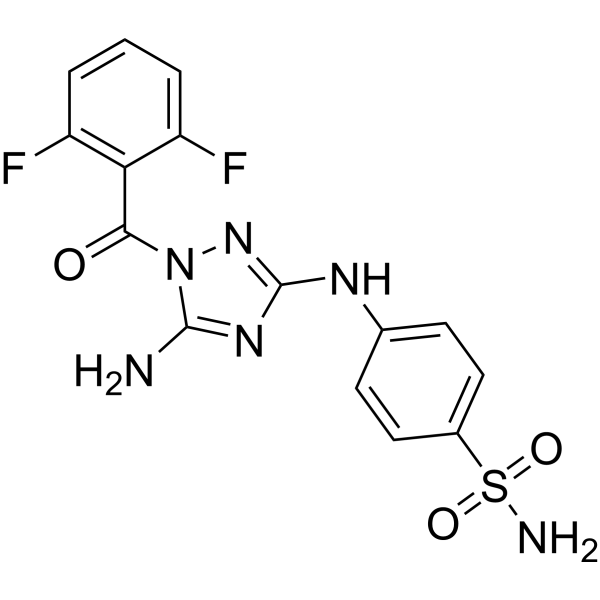Home
Products
JNJ-7706621



| Product Name | JNJ-7706621 |
| Price: | Inquiry |
| Catalog No.: | CN00224 |
| CAS No.: | 443797-96-4 |
| Molecular Formula: | C15H12F2N6O3S |
| Molecular Weight: | 394.36 g/mol |
| Purity: | >=98% |
| Type of Compound: | Alkaloids |
| Physical Desc.: | Powder |
| Source: | |
| Solvent: | Chloroform, Dichloromethane, Ethyl Acetate, DMSO, Acetone, etc. |
| SMILES: | Fc1cccc(c1C(=O)n1nc(nc1N)Nc1ccc(cc1)S(=O)(=O)N)F |
| Contact us | |
|---|---|
| First Name: | |
| Last Name: | |
| E-mail: | |
| Question: | |
| Description | JNJ-7706621 is a potent aurora kinase inhibitor, and also inhibits CDK1 and CDK2, with IC50s of 9, 3, 11, and 15 nM for CDK1, CDK2, Aurora-A and Aurora-B, respectively. |
| Target | CDK2/cyclinE:3 nM (IC50) cdk2/cyclin A:4 nM (IC50) Cdk1/cyclin B:9 nM (IC50) CDK3/Cyclin E:58 nM (IC50) CDK6/cyclinD1:175 nM (IC50) Cdk4/cyclin D1:253 nM (IC50) Aurora A:11 nM (IC50) Aurora B:15 nM (IC50) VEGF-R1:6400 nM (IC50) VEGF-R2:154 nM (IC50) VEGF-R3:735 nM (IC50) FGF-R1:575 nM (IC50) FGF-R2:226 nM (IC50) GSK3β:254 nM (IC50) |
| In Vitro | JNJ-7706621 shows antiproliferative activity against various human tumor cells with IC50s of 284, 254, and 447 nM for HeLa, HCT116, and A375, respectively[1]. JNJ-7706621 inhibits other centrosomal proteins such as TOG, Nek2, and TACC3 in early mitotic phase, but does not prevent localization of Aurora A to the spindle poles. Treatment of nocodazole-synchronized cells with JNJ-7706621 can override mitotic arrest by preventing spindle checkpoint signaling, resulting in failure of chromosome alignment and segregation[2]. JNJ-7706621 suspensions inhibits cell viability of HeLa cells with IC50s of 2.1 and 0.9 μg/mL at 24 and 48 h. The IC50 of the JNJ-7706621-loaded nanoparticles are 35 and 2.7 μg/mL and the IC50 of the JNJ-7706621-loaded micelles are 6.3 and 1.6 μg/mL[3]. JNJ-7706621 shows inhibition of Aurora-A and Aurora-B but has no activity at the highest concentration tested on the Plk1 or Wee1 serine/threonine kinases. JNJ-7706621 also shows potent growth inhibition in vitro on all human cancer cell types with IC50 values ranging from 112 to 514 nM[4]. |
| In Vivo | JNJ-7706621 (100 mg/kg, i.p.) exhibits 95% tumor growth inhibition in A375 (human melanoma) tumor xenograft model[1]. JNJ-7706621-loaded micelles inhibit tumor growth, and delay the tumor growth more efficiently than the control JNJ-7706621 suspension[3]. JNJ-7706621 (100 and 125 mg/kg) is efficacious in a human tumor xenograft model under intermittent dosing regimens[4]. |
| Cell Assay | HeLa cells are seeded in 96-well plates at the density of 2500 viable cells per well. The cells are then incubated with a suspension of JNJ-7706621, JNJ-7706621-loaded micelles and nanoparticles (JNJ-7706621 concentrations of 0.011, 0.022, 0.11, 0.22, 1.1, 2.2, 11 and 22 μg/mL; dilutions are made in the medium) and drug-free polymeric micelles (polymers concentrations 0.3 mg/mL) and nanoparticles (polymers concentration 5 mg/mL) for 4, 24 and 48 h. The cytotoxicity is assessed using the MTT test. Absorbance is measured at 570 nm using a microplate reader. Untreated cells are taken as control with 100% viability and Triton X-100 1% is used as positive control of cytotoxicity. The results are expressed as mean values ± standard deviations of five measurements. |
| Animal Admin | Briefly, animals are implanted s.c. with 1 mm3 A375 tumor fragments in the hindflank. After tumors reach 62 to 126 mg, groups are pair matched. Animals are given JNJ-7706621 or vehicle control starting on day 1. The tumor growth delay method is followed where each animal is euthanized when its neoplasm reached a predetermined size of 2.0 g. All statistical analyses are conducted using unpaired t tests at a P level of 0.05 (two tailed). |
| Density | 1.7±0.1 g/cm3 |
| Boiling Point | 676.6±65.0 °C at 760 mmHg |
| Flash Point | 363.0±34.3 °C |
| Exact Mass | 394.065979 |
| PSA | 154.37000 |
| LogP | 0.18 |
| Vapour Pressure | 0.0±2.1 mmHg at 25°C |
| Storage condition | -20℃ |